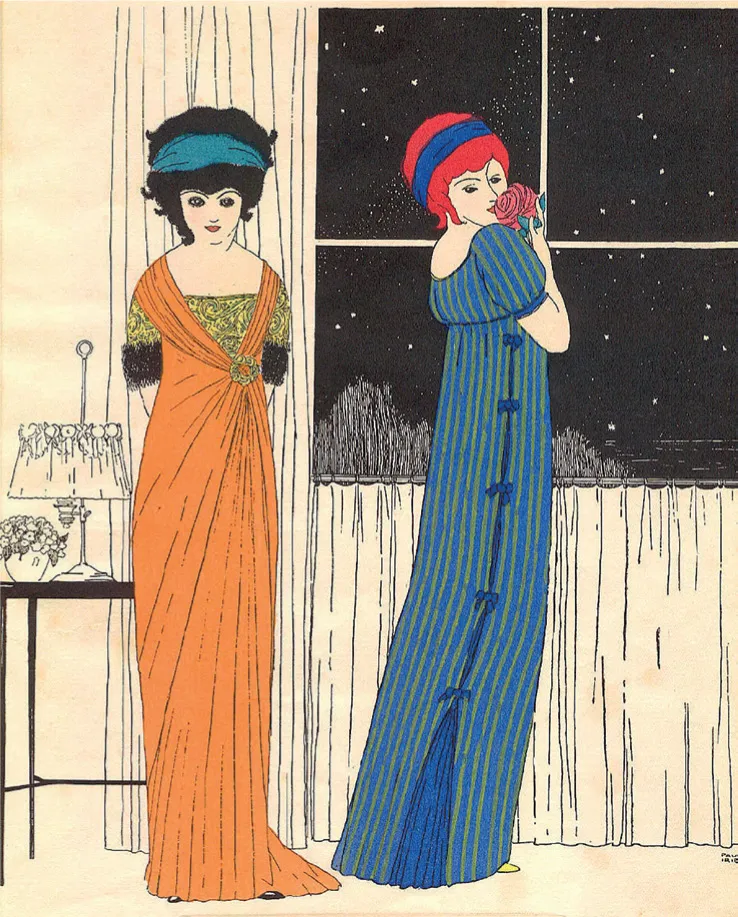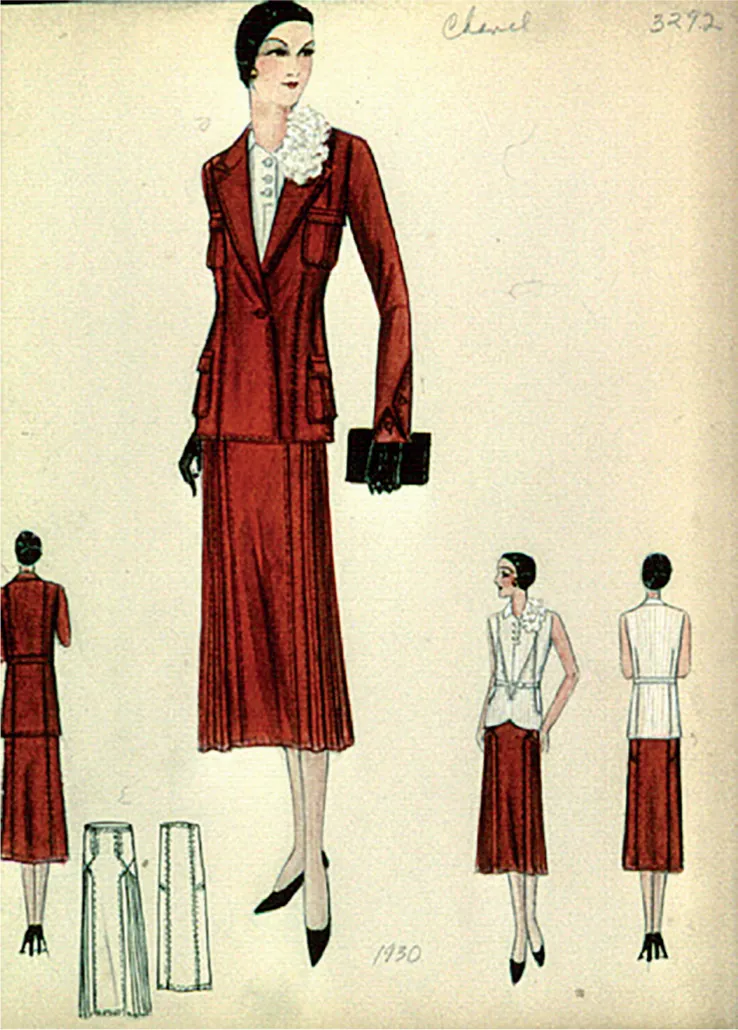![]()
1
Drawing to communicate your ideas
Drawing starts with imagination before it expresses itself as a means of generating or communicating an idea. In fashion, this can reveal a variety of approaches and styles that are linked to social, artistic and cultural values or influences.
This chapter includes an introductory survey of fashion drawing from the nineteenth century to more contemporary styles, and considers what defines a fashion sketch. Fashion sketching is discussed in the context of expressing an idea as part of a developmental process. The sketching process and the role of sketchbooks are further considered, with visual examples of working drawings to test and formulate an idea. Art supplies for fashion drawing are also discussed in this chapter to help readers gain a broader understanding of relevant media used for different types of fashion drawing. The chapter concludes with interviews from contemporary designers who discuss their approach to fashion drawing, media choices and their personal inspirations.
‘For me drawing is the magic connection between inspiration and expression.’
Jean-Charles de Castelbajac
A BRIEF HISTORY
From the mid-nineteenth century onwards, fashion-interest publications such as La Mode Illustrée, Gazette du Bon Ton and Modes de Paris published increasingly sophisticated fashion plates of the styles that emanated from Paris. These drawings became important cultural markers of fashion in their own right and began to influence the aesthetic view of dress styles, as well as to communicate the ‘looks’ of the day to their readers.
During the late nineteenth century, Parisian couturiers such as Charles Frederick Worth began to sketch their ideas for private clients. Typically these early examples of fashion drawings aimed for proportional realism, with the garment rendered in great detail.
1900s–1910s
At the turn of the century, while the prevailing look of the day was controlled by the constricting S-shaped corset, one notable illustrator with a distinctive drawing style defined a look that was referred to as the ‘Gibson Girl’. His name was Charles Dana Gibson, and his prolific pen and ink drawings were widely published and admired. Gibson portrayed an elegant, yet slightly aloof, woman who has been variously described as taller, more spirited but altogether feminine.
Following the extreme hourglass silhouette at the turn of the century, fashion details focused on the bustline, and the introduction of the sheath corset influenced a new, more elongated silhouette. Fashion drawings were largely inspired by the Art Nouveau movement, with an added infusion of exotic influences that included orientalism from the theatre, Tyrolean influences and the spectacle of the touring Ballet Russe.
In 1908, couturier Paul Poiret commissioned the young print maker Paul Iribe to draw his gowns for Les Robes de Paul Poiret, published in 1909. Using the pochoir process, Iribe applied his vibrant colours to each print using stencils for each colour. It was the first time a couturier had looked to modern art to represent his creations, and it redefined fashion illustration.
Watercolour, gouache and tempera were all used during this period as drawings took on a more ‘painterly’ approach. Watercolour paper or lightweight card was frequently used to prevent the water-based media from buckling the paper. The resulting fashion plates presented vibrant colours and linear clarity.
Gouache
A type of paint that consists of pigment suspended in water. Gouache differs from watercolour in that the particles are larger and the ratio of pigment to water is much higher. Gouache contains an additional inert white pigment such as chalk, which makes it heavier and more opaque, with greater reflective qualities.
Tempera
Tempera or ‘egg tempera’ is a type of paint made by mixing powdered pigments with egg yolk. Because tempera dried rapidly, artists had to apply it quickly with small brushstrokes in thin, semi-opaque or transparent layers. When dry, it produces a smooth matte finish.
Example of a Gibson Girl illustration by Charles Dana Gibson
1920s
During the 1920s the drawing style became more angular and linear in presentation, consistent with the changing silhouette and artistic move towards Art Deco. The new, ‘boyish’ figure appeared longer and leaner than before as the prevailing tastes changed.
Drawings began to reflect a frivolity as the new ‘flapper’ silhouette took centre stage. With the corset abandoned, fashionable women bound their breasts and wore simple slips as the waistline relaxed to hip level. The Japanese kimono became an important stylistic influence and beadwork and fringing often adorned the otherwise simple shapes. Watercolour and gouache media remained popular, while designers continued to apply fine-line ink or pencil to their work for definition and detail.
Fashion plate by Paul Iribe from Les Robes de Paul Poiret, 1909
1930s
As the exuberances of the 1920s gave way to the sobriety of the 1930s, the fashion silhouette became more elongated, sensual and feminine. Drawing styles reflected the new mood, becoming softer and more textural, while proportions returned to a more realistic interpretation. The surrealist art movement influenced fashion illustration styles during this period, with some notable collaborations between fashion couturier Elsa Schiaparelli and artists including Salvador Dalí and Christian Bérard, with whom she developed ‘shocking pink’ for one of her collections.
Fashion plate by Vionnet from the 1930s
Drawings took on a more lifelike appearance and the popularity of bias cutting in rayon and silk lent itself to a softer, almost slouchy silhouette. The emphasis on back detailing during this time, particularly on dresses, was reflected in the drawings; draping and surface patterns were rendered in inks, watercolours and gouache. Brushstrokes became noticeably more enhanced and were used to great effect, in combination with colour washes to soften the overall look. Women’s makeup was becoming more important as new face powders, mascaras and lipstick colours were developed and represented in the drawings, which exuded Hollywood glamour.
Fashion plate by Chanel from the 1930s
1940s
The austerity of the early 1940s saw another shift in the silhouette, with hemlines shortening, hats taking on a new significance and shoulder pads adding emphasis to a squared-off shoulder-line. Utility dressing and ‘make do and mend’ became practical necessities. The scarcity of resources during the Second World War was reflected in a more realistic drawing style. Watercolour and gouache were...




